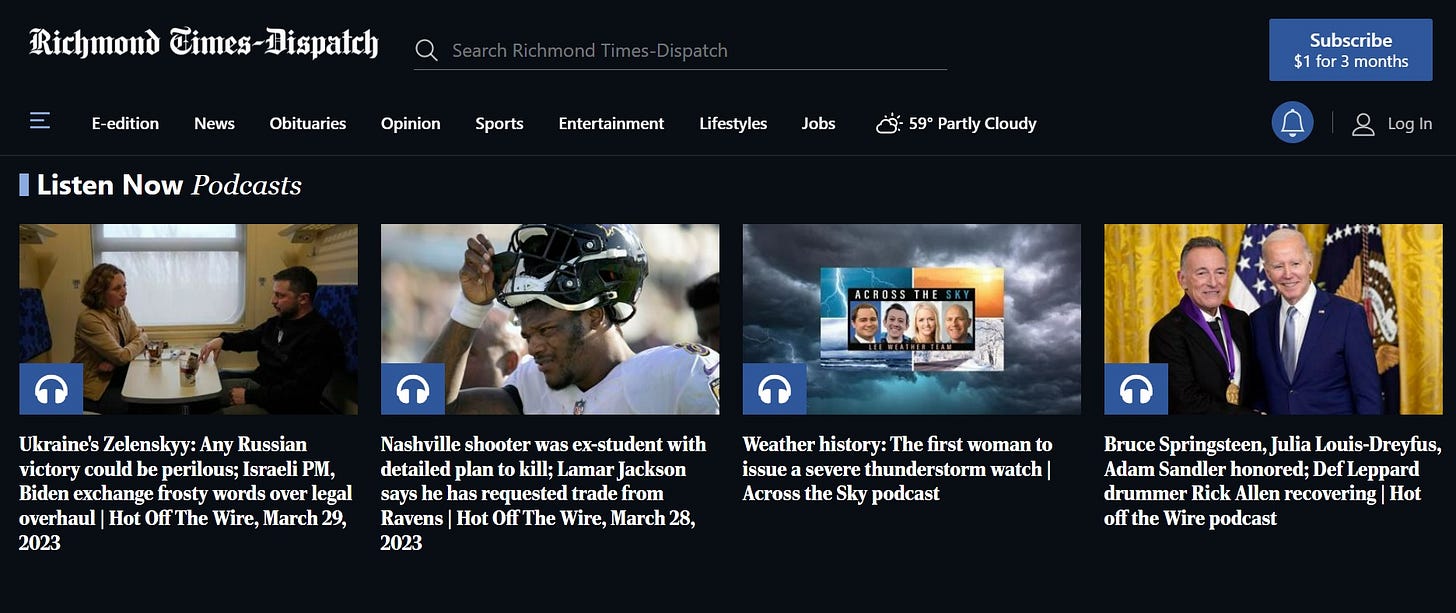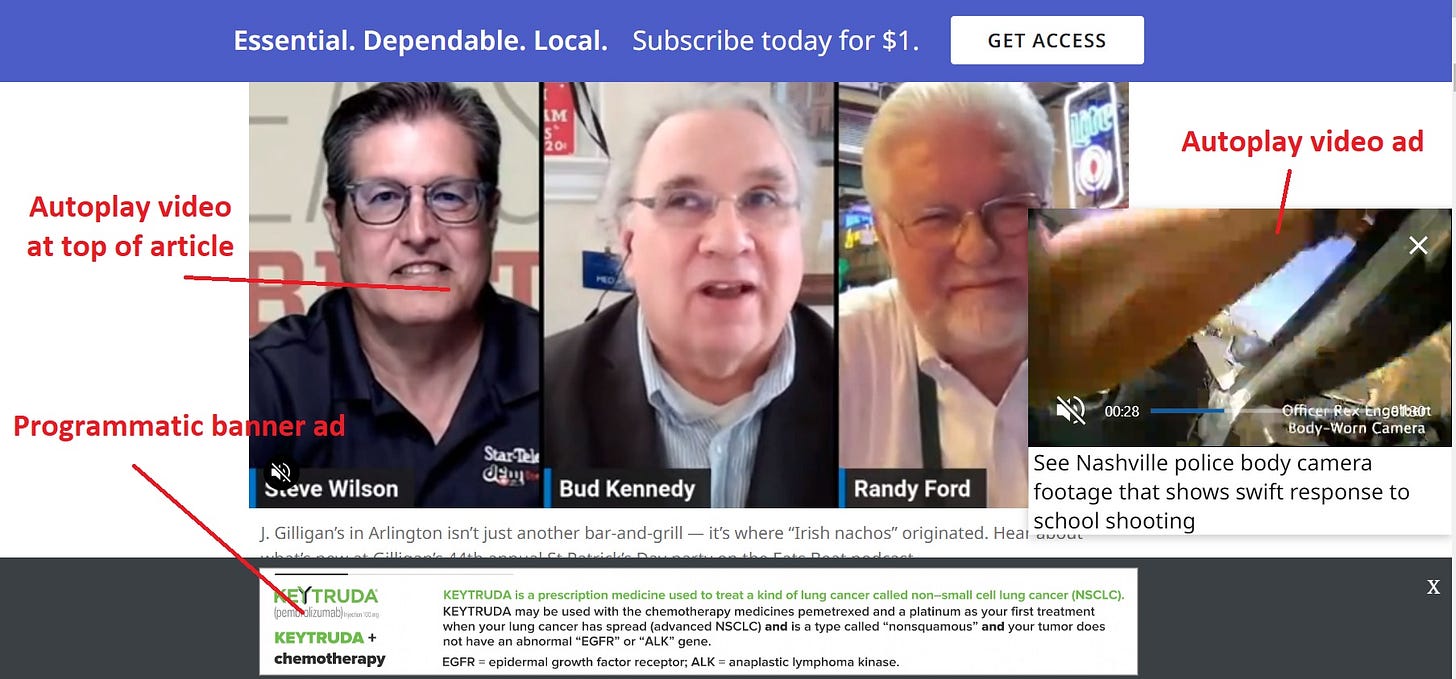
Discover more from Simon Owens's Media Newsletter
Local newspapers have lost the plot
...and what they can learn from the recent turnaround from Barnes & Noble.

Welcome! I'm Simon Owens and this is my media newsletter. You can subscribe by clicking on this handy little button:
Let’s jump into it…
Local newspapers have lost the plot
A few weeks ago, I put a call out in my newsletter for entrepreneurs who are running successful local news organizations. In the mainstream press, the local news industry is portrayed as being in a perpetual death spiral, but I knew from my own observations that there are hundreds of small, local startups that have either achieved sustainability or are very close to doing so.
After publishing that call-out, I saw a flood of inbound emails and social media mentions pointing me to thriving news orgs. That then led to phone calls with the leaders behind many of these outlets, and later this year I plan to have several of them on my podcast to talk about how they found viable business models for their content.
In the meantime, I want to call attention to three attributes that nearly every one of these outlets — whether nonprofit or for-profit — had in common:
They were online-only: In fact, not a single person I spoke to worked for a legacy print newspaper. Every outlet was launched within the last 15 years and published to the open web.
They’re extremely lean: You won’t find an ounce of fat on any of these outlets. They only hire when they have the budget to do so, they don’t spend lavishly on offices, and their newsrooms are relatively small compared to their legacy newspaper counterparts, at least from the pre-internet days.
They’re locally-run and hyperfocused on local news: You won’t see them publishing movie reviews, syndicating national columns, or covering Washington politics. These outlets are firmly entrenched in their local communities and put every available resource into covering those communities.
This hypervigilant, lean approach to news production is the opposite of what you see from just about every legacy print newspaper. Not only are traditional newspapers highly centralized — with the decision makers often far removed from the communities being covered — but they are still too focused on publishing commoditized, non-local news to websites that are so weighed down by programmatic ad tech that they’re barely functional.
Many of these legacy newspapers are owned by larger media chains, and it’s clear that they’re chasing audience scale in a way that doesn’t actually provide much value to local readers. As one media analyst told The Guardian recently, “The scale of online audience is very impressive but they’ve not worked out how to retain usage and build value for users. The majority of [local news] sites are nowhere near monetising sustainably. The focus seems to be on getting as many eyeballs on a page as you can, but it needs to be about what is valuable."
Don’t believe me? Fire up the website for the metro daily in just about any mid-sized city. Let’s start with The Richmond Times Dispatch, which is currently owned by newspaper chain Lee Enterprises. The homepage is littered with non-local stories. Tell me what any of these have to do with Richmond or Virginia:
The successful local news operators I spoke to wouldn’t waste even a square inch of homepage real estate on this type of content.
It’s not just the content that’s non-local. Many of these sites are plastered with programmatic ads for national and international brands. Take a look at this screengrab I took from an article published by the Fort Worth Star-Telegram, which is owned by McClatchy:
This is the kind of stuff that renders a site almost unusable and makes me dread clicking on just about any local news link, especially from my mobile phone. In recent years, many of these newspaper chains have invested in growing their paid digital subscriptions, but most have reported disappointing results. Could you imagine expecting a reader to convert to paid after subjecting them to this level of abuse?
Again, none of the successful local media operators I spoke to even bothered with programmatic advertising. In cases where they did accept sponsorships, it was almost solely from local businesses and organizations. This not only maximized value for those advertisers, but it also provided some additional value to the readers who were exposed to those local businesses. Believe it or not, local readers actually appreciate when they’re alerted to news about a new restaurant or community activity.
This isn’t to say that newspaper chains can’t succeed, but it’s clear that their heavy-handed, top-down approach to content production and revenue generation isn’t working. They should instead look to the success of Barnes & Noble — a company that’s experienced an impressive turnaround in recent years by empowering its local store managers — for ideas on how to manage their media properties. Here’s how writer Ted Goia described the strategy:
“Staff are now in control of their own shops,” [CEO] James Daunt explained. “Hopefully they’re enjoying their work more. They’re creating something very different in each store.”
…Daunt used the pandemic as an opportunity to “weed out the rubbish” in the stores. He asked employees in the outlets to take every book off the shelf, and re-evaluate whether it should stay. Every section of the store needed to be refreshed and made appealing.
As this example makes clear, Daunt started giving more power to the stores. But publishers complained bitterly. They now had to make more sales calls, and convince local bookbuyers—and that’s hard work. Even worse, when a new book doesn’t live up to expectations, the local workers see this immediately. Books are expected to appeal to readers—and just convincing a head buyer at headquarters was no longer enough.
The NYT’s Ezra Klein had a similar assessment of the winning strategy:
Daunt’s focus has been devolving power to local store managers. A great bookstore, he thinks, is a reflection of the community in which it exists. A Barnes & Noble next to a thriving church needs to be different from one down the street from a high school. He has been unwinding the deals the company made that let publishers pay for placement, deals that have prevented local stores from choosing what to display or stock.
Imagine if these nationally-run newspaper chains started putting more power into the hands of the local editors, reporters, and sales staff — giving them a mandate to focus solely on delivering value as defined by their local communities. No more chasing scale for the sake of scale. No more plug-and-play ad and content units that do nothing to serve their audience.
Look, I don’t think we’ll ever get back to the pre-internet era in which newspapers operated as local monopolies that benefited from fat profit margins and lavish budgets. But I also think the widely-held belief that local news is unsustainable without government assistance is wrong. Communities value local news and will often reward it with both their attention and money. I just believe that many of the chains and private equity funds that own legacy newspapers have lost sight on how to actually deliver on that value.
What do you think?
Your ad here
86% of my audience works in media, the creator economy, marketing, and/or tech. If you have a product or service targeted toward these types of workers, then you should consider becoming a sponsor for this newsletter. You can find all the details over here.
How Worldcrunch is bringing non-English content to a Western audience
Historically, foreign correspondents haven’t been the type of journalists who break major news stories in the countries they cover. That’s because they’re typically not as well sourced as the local reporters who grew up in a particular region and have an intimate knowledge of its issues.
But what would happen if you could take the work of local reporters and translate it for English-speaking readers? That’s the idea behind Worldcrunch, a media outlet that was founded in 2011. Rather than creating all of its own content, it syndicates articles from publications all around the world and then pays translators to adapt those articles for a Western audience.
In a recent interview, founder Jeff Israely talked about his years of work as a foreign correspondent for Time Magazine and how that fueled the idea for Worldcrunch. He also discussed the publication’s evolving business model as it moved from syndication to advertising and subscriptions.
You can find our discussion in the video embedded below:
Video embeds not work in your inbox? You can find it over here.
Quick hits
Over the last few years, NPR took steps to diversify its content lineup by investing in new podcasts that weren't tied to its radio programming, but its recent layoffs signal a return to a strategy centered around traditional broadcasting. [Vulture]
Substack is pitching its own users on becoming investors. [Substack] A veteran journalist who built a substantial following on Substack explains why he's investing in the company. [Ted Goia] The Verge comes in with the cynical take on Substack's decision to allow its users to invest in the company. [The Verge]
"Since 2019, when Google opened the floodgates for any publisher to be eligible for Google News and top stories, original news reporting has struggled with copycat publishers regurgitating the news without attribution." [Press Gazette]
Investors definitely overestimated how quickly the esports industry would grow and they're currently not in a hurry to pump more money into it. [Sports Business Journal]
Jonah Peretti once posited that if he could just merge with several other digital media companies, then BuzzFeed would reach enough scale to better negotiate advertising prices and achieve profitability. That theory hasn't been borne out. [CNBC]
ICYMI: How a kids-focused podcaster reached 1 million monthly downloads
Jim Jacob accidentally stumbled upon a huge market opportunity when he launched Kids Short Stories.
Let’s hang out more often
I only send out this newsletter twice a week. Here are some places where I curate and comment on industry news on a daily basis:
Do you like this newsletter?
Then you should subscribe here:
Simon Owens is a tech and media journalist living in Washington, DC. Follow him on Twitter, Facebook, or LinkedIn. Email him at simonowens@gmail.com. For a full bio, go here.

















Great column on local news. Agree 100%.
The programmed ads on newspaper and blog websites drive me crazy. It creates such a terrible user experience.